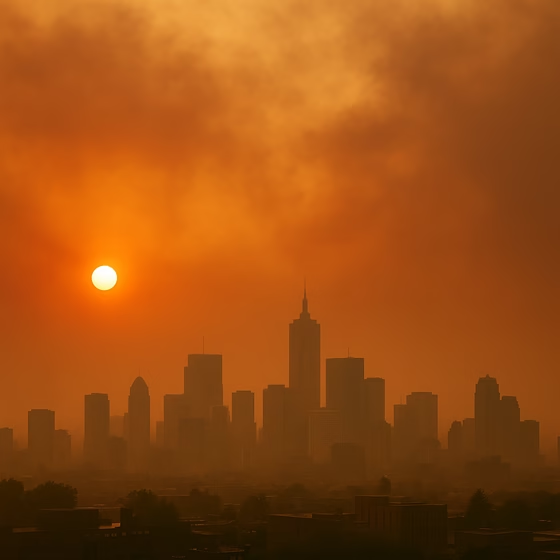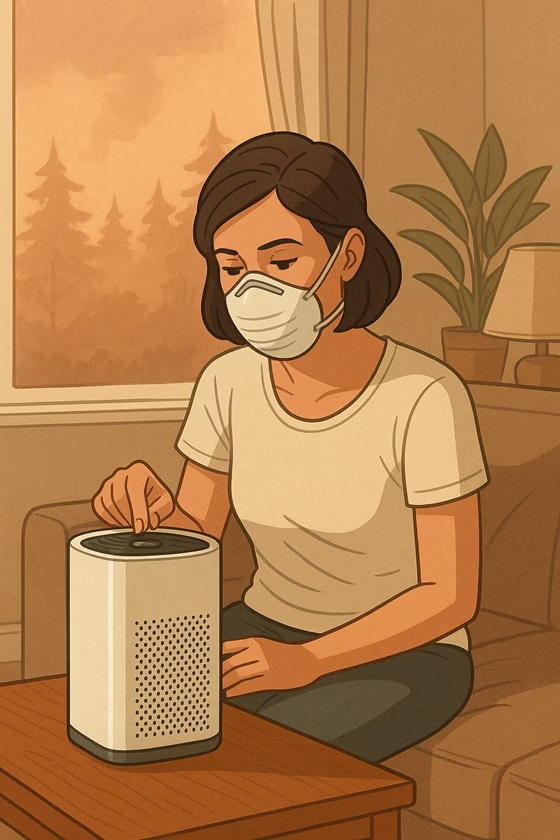Wildfire Smoke and Your Health: Risks, Tips and Protection
A hazy orange sun hangs over the city, casting an eerie glow through the thick smoke. The smell of burning wood seeps into homes and schools, and it becomes hard to breathe. Wildfires—once mostly a rural concern—are now affecting urban areas across North America and beyond. Understanding the dangers of wildfire smoke and how to protect yourself is critical as climate‑driven fire seasons become longer and more intense.
Why Wildfire Smoke Is Dangerous
Unlike typical urban air pollution, wildfire smoke contains a cocktail of harmful particles and gases. Researchers at Stanford University warn that there is no safe level of exposure to wildfire smoke[1]. In fact, smoke from burning trees, grasses and homes is about ten times more toxic than the same amount of pollution from vehicles or factories[1]. The tiny particles (PM2.5) can penetrate deep into the lungs and even enter the bloodstream, carrying with them heavy metals, carcinogens and other toxins.

Who Is Most Vulnerable?
While smoke affects everyone, certain populations are at greater risk:
- Children – Developing lungs are more sensitive, and kids breathe faster than adults.
- Older adults – Age‑related changes make lungs less able to clear particles; many seniors also have chronic diseases.
- Pregnant people – Exposure can increase the risk of low birth weight or preterm birth[1].
- People with preexisting conditions – Asthma, COPD, heart disease and diabetes can worsen when air quality declines[2].
If you belong to any of these groups—or care for someone who does—extra precautions are essential during smoky periods.
Health Effects of Smoke Exposure
Short‑term exposure to wildfire smoke can cause:
- Coughing and throat irritation.
- Shortness of breath and chest tightness.
- Headaches, dizziness and fatigue.
- Eye irritation and blurred vision.
Long‑term exposure increases the risk of heart attacks, strokes and respiratory diseases[1]. Emerging research also links smoke exposure to cognitive decline and mental‑health issues.
Protective Measures
You can’t control the fires, but you can control your exposure. Health experts recommend:
- Monitor air quality – Check indexes like Air Quality Health Index (AQHI) or AirNow. Stay indoors when levels are unhealthy.
- Use high‑quality masks – N95 or KN95 masks filter out most fine particles. Surgical or cloth masks offer little protection.
- Create a clean room – Use a portable HEPA air purifier in one room and keep windows and doors closed. DIY purifiers with box fans and furnace filters also work.
- Seal your home – Install weather stripping, close fireplace dampers and use bathroom exhaust fans sparingly.
- Limit physical exertion – Avoid outdoor exercise. Choose indoor workouts until air quality improves.

Children and Indoor Activities
Keeping kids entertained indoors during smoky days can be challenging. Encourage activities like reading, board games, art projects or online classes. Use air purifiers in play areas, and avoid burning candles or incense, which add indoor pollutants. If smoke infiltrates your home, consider visiting a clean‑air shelter or library.

Long‑Term Solutions
Wildfire smoke is a symptom of larger environmental problems. Climate change has lengthened fire seasons and increased the frequency of extreme fires. Addressing carbon emissions and investing in forest management can reduce future smoke events. Communities should also develop emergency response plans, improve building codes and expand public clean‑air spaces.
Conclusion: Take Air Quality Seriously
As fires become more common, understanding the health risks of wildfire smoke is crucial. Simple actions—checking air quality, wearing N95 masks and using air purifiers—can dramatically reduce your exposure. To learn about another natural phenomenon with global effects, read our piece on the August solar storm and the northern lights. For real‑time air‑quality updates and guidance, visit AirNow.gov or your local health authority.
Call to Action: Share your smoke‑proofing tips in the comments, and sign up to receive environmental health news and safety alerts.
[1] [2] What we know about the health effects of wildfire | Stanford Report
https://news.stanford.edu/stories/2025/01/assessing-wildfire-health-risks
